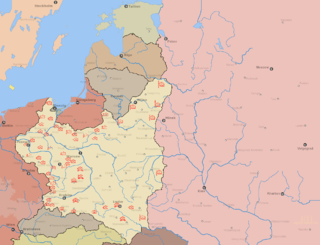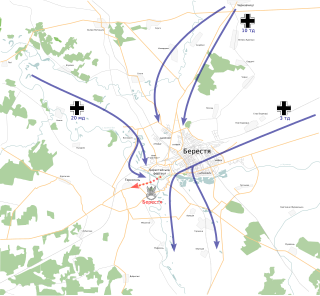
Operation Tempest was a series of uprisings conducted during World War II against occupying German forces by the Polish Home Army, the dominant force in the Polish resistance.

The Battle of Kock was the final battle in the invasion of Poland at the beginning of World War II in Europe. It took place between 2–5 October 1939, near the town of Kock, in Poland.

This article discusses the Polish order of battle during the invasion of Poland. In the late 1930s Polish headquarters prepared "Plan Zachód", a plan of mobilization of Polish Army in case of war with Germany. Earlier, the Poles did not regard the Germans as their main threat, priority was given to threat from the Soviets.

The siege of Warsaw in 1939 was fought between the Polish Warsaw Army garrisoned and entrenched in Warsaw and the invading German Army.

The Battle of the Bzura was the largest Polish counter-attack of the German invasion of Poland and was fought from 9 to 19 September. The battle took place west of Warsaw, near the Bzura River. It began as a Polish counter-offensive, which gained initial success, but the Germans outflanked the Polish forces with a concentrated counter-attack. That weakened Polish forces and the Poznań and Pomorze Armies were destroyed. Western Poland was now under German occupation. The battle has been described as "the bloodiest and most bitter battle of the entire Polish campaign". Winston Churchill called the battle an "ever-glorious struggle".

The Battle of Brześć Litewski was a World War II battle involving German and Polish forces that took place between 14 and 17 September 1939, near the town of Brześć Litewski. After three days of heavy fights for the stronghold in the town of Brześć, the Germans captured the fortress and the Poles withdrew.

The Battle of Tomaszów Lubelski took place from 18 September to 20 September 1939 near the town of Tomaszów Lubelski. It was the second largest battle of the Invasion of Poland and also the largest tank battle of the campaign. It resulted in the surrender of Army Krakow on 20 September 1939.
The Prusy Army was one of the Polish armies to fight during the Invasion of Poland in 1939. Created in the summer of 1939 as the main reserve of the Commander in Chief, it was commanded by Gen. Stefan Dąb-Biernacki. The word Prusy in the Polish language means Prussia, but this name only served as a codename and the region of operations of this army was far from East Prussia. This is in contrast to other Polish armies in 1939 which were named after the geographical regions where they formed. The Prusy Army, whose original name was Warszawa Army, was named so after a folwark in central Poland called Prusy, which served as the headquarters of General Dąb-Biernacki.

The Battle of Radom, also known as the Battle of Iłża, was part of the Invasion of Poland during the Second World War. It lasted from 8 September 1939 to 9 September 1939. Polish troops of the Prusy Army, under General Stanisław Skwarczyński, defended the city of Iłża and the road from Sandomierz to Radom. The Poles were not ready to meet head on overwhelming German XV Army Corps, and were easily defeated after two days of fighting. Prusy Army, in the aftermath of the battle, ceased to exist. Some of the army's units joined other tactical groupings of the Polish armed forces.
Kraków Army was one of the Polish armies which took part in the Polish Defensive War of 1939. It was officially created on March 23, 1939 as the main pivot of Polish defence. It was commanded by Gen. Antoni Szylling. Originally, Kraków Army was to be made of seven infantry divisions, two cavalry brigades and one mountain brigade. On September 1, 1939, General Szylling had the force which consisted of five infantry divisions, two cavalry brigades and one brigade of mountain infantry. Altogether, the army was made of 59 battalions, 29 squadrons, 352 cannons, 90 tanks, two armoured trains and 44 planes. These forces were not enough to halt German advance, especially in the area north of Częstochowa, where Kraków Army connected with Łódź Army. Main thrust of Wehrmacht panzer units was directed there, and this area was defended only by the Polish 7th I.D., which was destroyed in the early days of September 1939, opening the way towards central Poland.

Łódź Army was one of the Polish armies of the Polish Armed Forces of the Second Polish Republic that took part in the Invasion of Poland of 1939. It was officially created on 23 March 1939 with the task of filling the gap between Poznań Army in the north and Kraków Army in the south. Commanded by Juliusz Rómmel, it consisted of five infantry divisions and two cavalry brigades with support from the air force.
The Warszawa Army was one of the Polish armies to take part in the Polish Defensive War of 1939. Created on 8 September, eight days after the invasion begun, it was an improvised formation charged with the defence of the Polish capital of Warsaw (Warszawa).
The Polish 4th Infantry Division was created following Polish independence after the end of World War I. The division participated in the Polish–Ukrainian War in 1919. During World War II, the division existed as three wholly separate organizations, the original incarnation of the division as part of the pre-war Polish Army, the second incarnation armed and equipped by the western Allies, and another division armed and equipped and controlled by the Soviet Union. The second and third incarnations of this division existed simultaneously from 1944 until 1947.
The Warsaw Armoured Motorized Brigade was a motorized unit of the Polish Army during the interbellum period. The brigade was one of two such units in Poland. Not fully formed by September 1, it was nonetheless partially combat ready and immediately rushed into battle during the Polish September Campaign. Following heavy losses during the Battle of Tomaszów Lubelski, it was disbanded on September 20, 1939.
Polish 3rd Legions Infantry Division was a tactical unit of the Polish Army between the World Wars. Formed in 1919, as a third unit composed significantly of veterans of the Polish Legions in World War I, it saw extensive action during the Polish-Bolshevik War and the Invasion of Poland. In the interbellum period, the headquarters of the division was stationed in Zamość, while its regiments were garrisoned in Chelm, Lublin, Zamosc and other locations.
5th Lwów Infantry Division was a unit of the Polish Army in the interbellum period, with headquarters stationed in Lwów. It was created on May 20, 1919, during the Polish–Ukrainian War in Eastern Galicia. Originally, it consisted of three infantry regiments, but later it was strengthened with additional two. During Polish September Campaign it was commanded by General Juliusz Zulauf. The Division consisted in September 1939 of these regiments:
The Polish 39th Infantry Division was a reserve unit of the Polish Army, which took part in the Polish September Campaign. Commanded by General Bruno Olbrycht, it was part of the Prusy Army and was concentrated in the area of the Holy Cross Mountains.
The 36th Reserve Infantry Division was a unit of the Polish Army in the interbellum period, which took part in the Polish September Campaign.
Polish Northern Front (1939) was an operational unit of the Polish Army in the Invasion of Poland. It was created by order of Marshal Edward Rydz-Śmigły, on September 10, 1939.

4th Niemen Uhlan Regiment was a cavalry unit of the Polish Army in the Second Polish Republic. It was garrisoned in the city of Vilnius, and it celebrated its day on 9 July, the anniversary of the 1920 Charge of Hrebionka.












